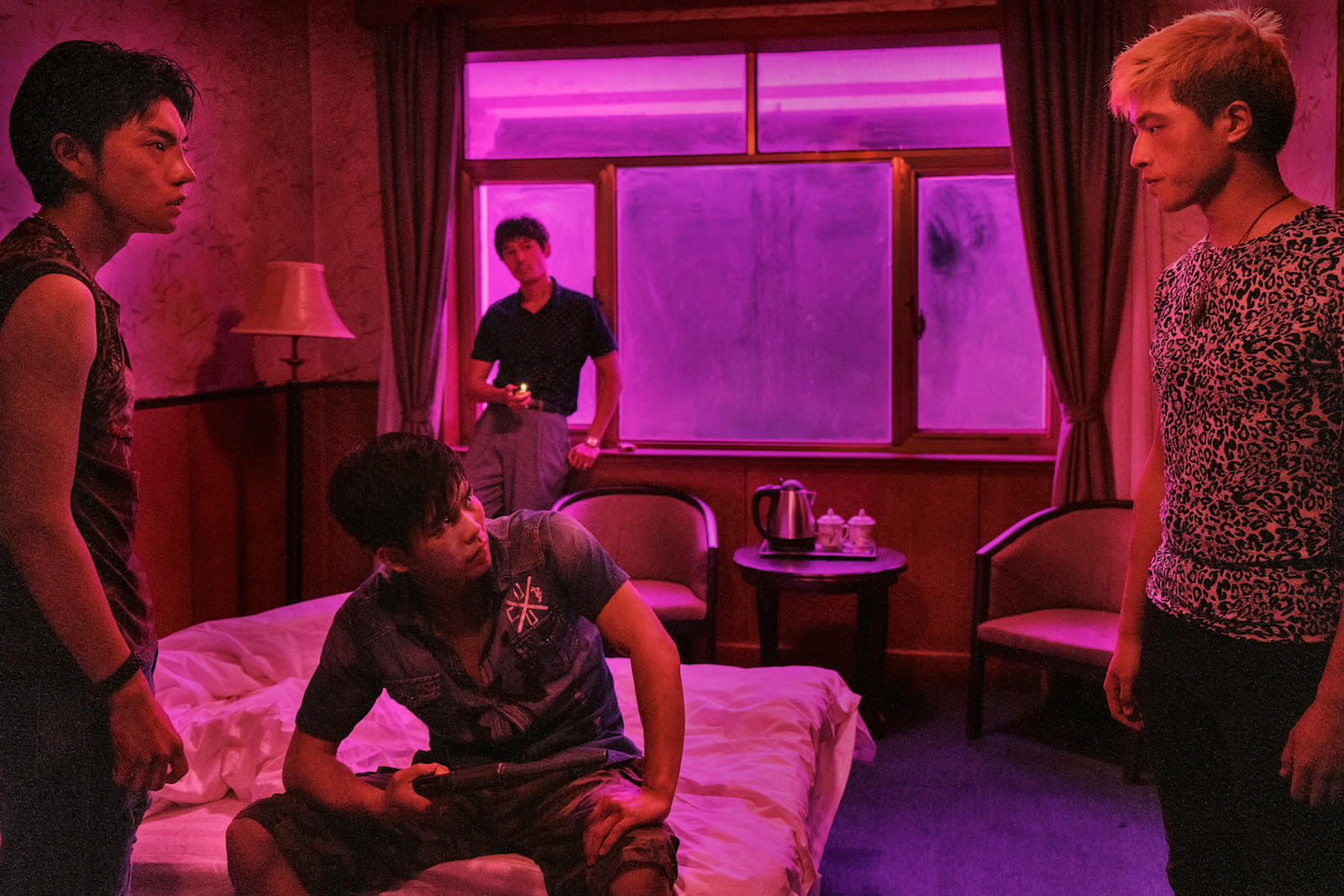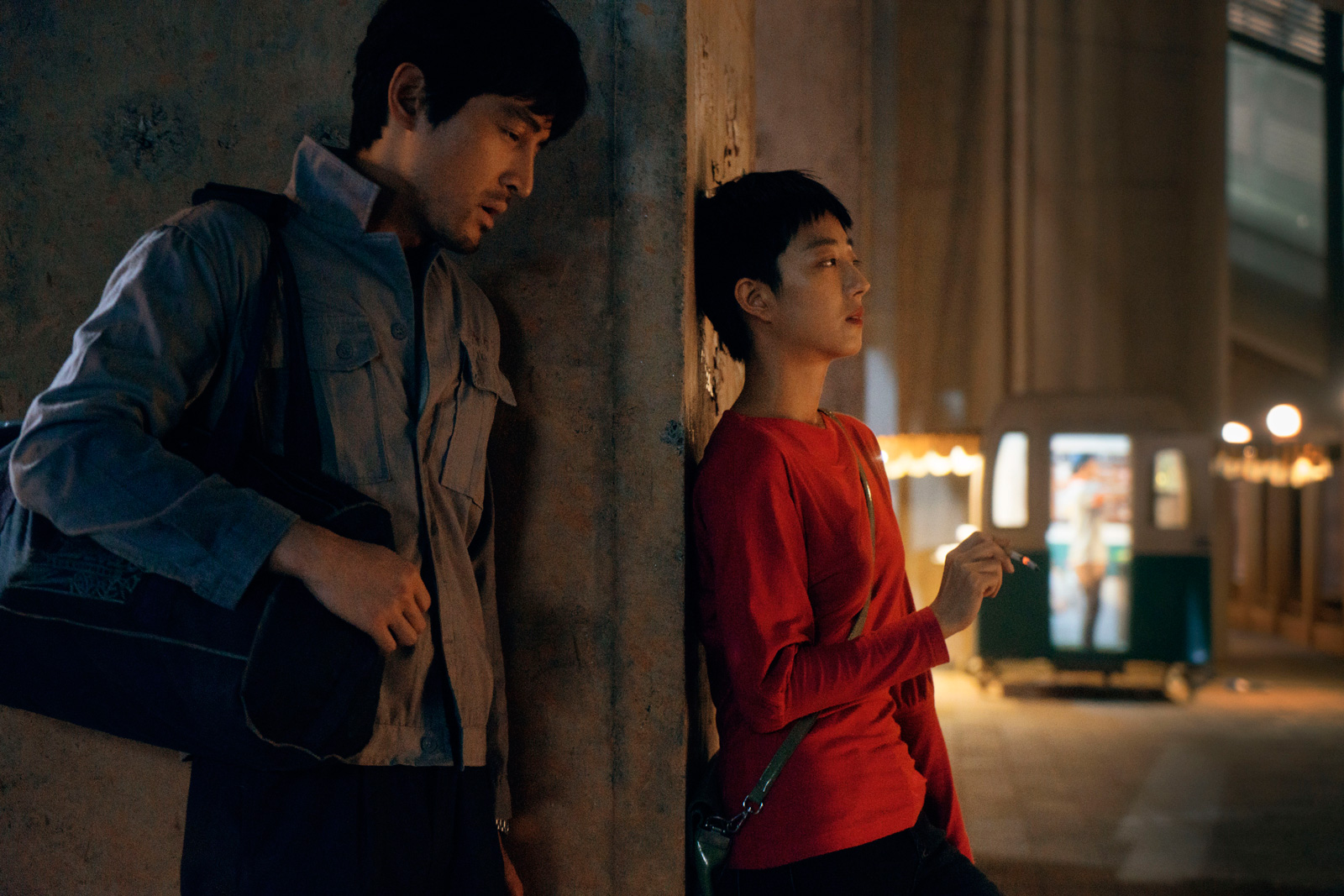The story of Diao Yinan’s new film, The Wild Goose Lake, is simple, almost allegorical: a man of the underworld is thrust onto a perilous journey to death to redeem himself. Zhou Zenong (Hu Ge) leads a gang that specializes in stealing motorbikes in the streets of Wuhan. After mistakenly killing a cop on the road, Zhou knows he is doomed. So he hatches a scheme to turn the hefty bounty on his head into a final gift for his family. After a botched attempt to get his wife (Wan Qian) to report him to the police, another woman Liu Ai’ai (Gwei Lun-mei), a “bathing beauty,” steps into the accomplice role and helps him finally accomplish the mission against tremendous odds. The film ends with Ai’ai and Zhou’s wife walking together side by side, carrying a bag of cash.
Zhou Zenong is resigned to his imminent death not because the crime squad is particularly capable. In one scene in which Captain Liu (Liao Fan) gathers his team to set up the operation, the officers are so unconfident about using firearms that they ask for retraining. What really makes Zhou sure about his sealed fate is his realization that he has committed an unforgivable crime and that he cannot escape an all-out man hunt in a surveillance society.
Ironically, it is also through a clip of surveillance footage Diao uses that one can identify 2012 as the year in which the story is set. In an interview, the director explained that the events he uses in the film “all had their sources in real life,” including the episode about the “Congress of the Thieves.” Even the city map that a gangster uses at the congress is a real detail. Zhou Zenong corresponds to a real-life fugitive, Zhou Kehua, who was captured and killed by the police in the summer of 2012 after committing a series of armed robberies. His girlfriend was epileptic, as Zhou Zenong’s wife is in the film. The year 2012 also happened to be when Xi Jinping became the president of China, the beginning of a new era of the increased surveillance in an already hyper-vigilant state. This, of course, is only an inference. Nothing is spelled out.
This oblique approach to “Chinese issues” is part of Diao’s eclectic, dissonant film style. In one of the film’s most striking set-pieces, the roving camera follows Zhou Zenong meandering through a run-down apartment building after he has killed two of his gangster enemies. Taking advantage of the austere look of the concrete-and-steel building, Diao creates an atmospheric mise-en-scène of nocturnal violence and mystery. An eye-tricking 360-degree point-of-view shot, which switches from Zhou to an unlucky couple passing by (with the man hit by a bullet aimed at Zhou), intensifies the mêlée that suddenly erupts. But the director tries to do something more. Echoing an earlier series of quick cuts that show the unruly and derelict public places the police raid in order to ferret out Zhou, this time Diao’s bold camera follows the fugitive himself entering the private domain of people on the fringe of society, catching them on the fly amid their dire living conditions.
In one scene, Zhou Zenong invades a nondescript home. When he pulls back a curtain hung in the middle, we see an old man lying alone in his bed. All skin and bones, he looks so weak that even at the sight of the trespasser, all he can do is to open his mouth in a failed attempt to emit a shout or scream. Is this famished man handicapped, or neglected, or dying alone silently? Diao’s camera does not stop to discover. When it tracks past a line of disgruntled residents roused from their sleep or a crowd of small-business owners who are drawing lots to fulfill a forced relocation plan, the camera lingers only long enough to hint at their anger. Yet the curtain is drawn aside. The dark is exposed.
The way Diao blends social criticism into the noir form indicates the influence of the French New Wave. In fact, all of his films reflect his attraction to both arthouse cinema and genre movies, especially to works straddling both categories. He admires Jean Renoir, François Truffaut, Jean-Luc Godard, and Hou Hsiao-hsien, but is also fascinated by Jean-Pierre Melville and Claude Chabrol. His use of shadow in The Wild Goose Lake reminds one of Fritz Lang’s M (1931) and Orson Welles’s The Stranger (1946). A shootout scene outside a noodle shop even has a Hitchcockian ring, recalling the amusement park in Strangers on a Train (1951).
Yet it would be unfair to characterize The Wild Goose Lake as imitative. Its staging of sudden violence and overwhelming chaos is striking and original. The camera that explores the fluidity between image and reality, as in a tracking shot in which Liu Ai’ai walks past an immense real estate poster, is inventive, lyrical, and intense. At the same time, rhythmic percussion and gestures borrowed from Peking opera create a stylized contrast with his “accidental” verité snapshots. Resplendent details, like the neon lights that bathe a hotel room in a suffocating hot-pink and the luminous LEDs that make both the gangsters’ bikes and the police’s sneakers glow, add a lush visual theatricality to Diao’s film.
Advertisement
The Wild Goose Lake is Diao Yinan’s first film since he won a Golden Bear for Black Coal, Thin Ice in 2014, and is only his fourth since Uniform, his 2003 debut. His China noir may appear limited in scope and ambition to critics who admire the grand scale and purist arthouse style of Jia Zhangke, but the psychological subtlety and social awareness that Diao brings to his drama are anything but small. Black Coal, Thin Ice and his less-known second film Night Train (2007) are two exemplary cases that push the boundary of crime stories to explore the “lower depths” in psychosexual and social terms. Despite its choreographed violence and a “southern” accent associated with the locale—a departure from his earlier films, The Wild Goose Lake continues Diao’s hybrid approach to genre movie and art film.
The new film also reflects Diao’s enduring fascination with the struggle between eros and death. In the amusement tent of a funfair, Zhou Zenong, who was pursuing Ai’ai, is distracted by the sight of a woman’s head that looks as if it’s suspended above a vase in a red-velvet-lined metal box. With her eyes closed at first, she blinks awake and gazes at Zhou when he approaches, as though beckoning him. When he feeds a coin into the slot, the device immediately starts rotating and playing a song, like an old-fashioned wind-up musical box. The surreal, fetishistic scene—drawn, as Diao told me, from his own memory—is almost too ripe for Freudian Interpretation, with a new twist in capitalist China. Diao’s clever play with shot and reverse-shot displaces the fear of castration that Ai’ai represents onto her automaton double operated by cash.
“All true feeling is in reality untranslatable,” wrote Antonin Artaud in The Theatre and Its Double. “To express it is to betray it. But to translate it is to dissimulate it.” What does Diao’s intoxicating mix of the lurid and the luminous dissimulate? What is his promiscuous use of spectacle and theatrics intended to mask? Zhou seems to achieve a heroic status when he acts contradictorily to both evade and embrace death, so that the bounty on his head can replace him for his family. Yet one might ask whether all the visual dazzle and exhilarating actions can really elevate a criminal fugitive to an existential hero, just as the film seems unable to answer whether money, such a destructive force in the film, can really offer salvation. The glimmer of hope, suggested by Ai’ai’s final chivalrous act and by her seeming solidarity with Zhou’s wife, is too faint to lift the grim sky of the film.
The Wild Goose Lake is not by any means the first Chinese film to be set in Wuhan, but it’s rare to hear an entire cast speak the Wuhan dialect and see the city’s real locations—especially its lake and “urban villages”—feature in a high-profile film. Today, it is the coronavirus outbreak, not Diao’s film, that has put Wuhan on the world map. Yet the film seems, if anything, to have taken on a darker poignancy since it premiered four months ago at the New York Film Festival. So many of the noirish expressions in Diao’s drama of demise and redemption—the unforeseen burst into chaos in the “uncharted zone,” the sudden strike of death, the suppressed despair and discontent, the submission to fatalism—are now shading into the harrowing images that are flowing daily into our collective consciousness.
The Wild Goose Lake, directed by Diao Yinan, is now in theaters. Uniform (2003) and Black Coal, Thin Ice (2014) are streaming on Amazon Prime. Night Train (2007) is available on DVD.




